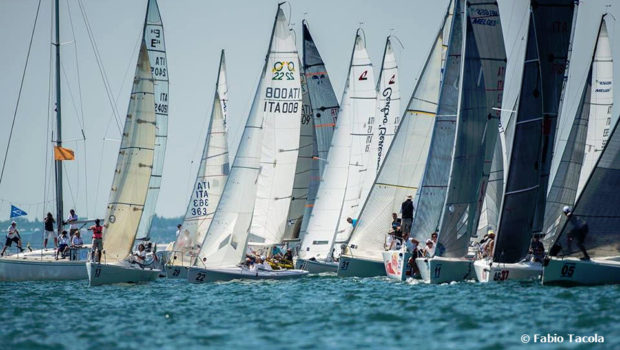Re-sparking Interest in Local Racing
Published on March 22nd, 2017
Combine the popularity of keelboat one design racing, with the growth of speedy sportboats, and our sport has seen a long line of attempts to launch one design classes. However, there hasn’t been much success in the 30-foot range.
What often happens is there are enough buyers to get the ball rolling, but not enough in any one region. So the boats have to travel, which is expensive, or the demands of the boat and schedule require pro crew, which is expensive. Ultimately the ball stops rolling and participation suffers.
“It is much harder to build a strong and vibrant International Class Association than design a new boat.” – Paul Elvstrom, 4-time Olympic gold medalist
Multi world champion Vince Brun, recently retired from North Sails, doesn’t like the trend he is seeing, as he shared with Sailing World.
“One-design racing has been great for sailing and great for the industry,” says Brun. “We have been able to develop our sail products and our tuning guides to allow our customers and others to better enjoy the close competition that one-design sailing provides.”
But as Brun has observed, when one-design racing is not available, too many boats remain idle on trailers in his home area of San Diego. “Many of these boats are really fun to sail, and they should be sailed and not just sit waiting for a one-design class to form,” he says.
Activating these boats under a measurement rule is the solution. This separates the sportboats from the bread-and-butter PHRF crowd and provides these technical boats with a technical rule designed to properly rate, without politics, different boats to allow for fair racing.
“There are lots of older, fast 30-footers, like Mumm 30s and Henderson 30s, that are around, and they could be grouped into a new Fast 30 class, along with more-modern boats, like the C&C 30 and Farr 280, and enjoy good, close racing,” Brun says.
Unlike one design racing, where tactics are only about beating the other boat, handicap racing requires a different level of thought. Success is based on who best sails the course, avoiding boat-on-boat conflict to complete the course in the fastest time. This can shuffle the usual pecking order found in small one design fleets.
“If we could place all these designs into one class at the big events, it would be a great way to test and establish the concept,” continued Brun. “I’m confident that after a few owners experience sailing under the new class, we could easily market the idea to other lengths, and get more people motivated to come back out and go racing.
The idea is actually not new — there’s already an ORC Sportboat European Championship and there was a class formed at Quantum Key West Race Week in 2016. However, the idea is now gaining traction among West Coast race organizers, such as the Helly Hansen NOOD Regatta in San Diego, San Diego YC’s Yachting Cup, and North Sails Race Week in Long Beach.
“The ORC rating tools might be correct for this concept since they are measurement-based, objective, and have been developed successfully for a wide variety of boat types,” says Brun. “With this approach, we want everyone to feel confident they can get out and race others and have fun, whether in one-design or not. This could help re-spark interest and variety in local racing — something that benefits everyone.”
Sailing World is the dominant North American magazine for anyone serious about their racing. Subscription details for their magazine or iPad can be found here.









 We’ll keep your information safe.
We’ll keep your information safe.